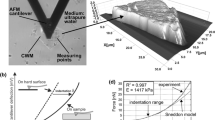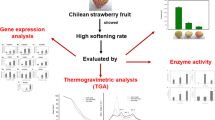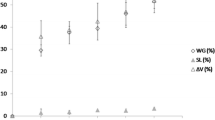Abstract
Olive fruits processed as “Spanish green olives” were sorted into two batches depending on their pitting behaviour: those that broke under punch pressure, and those that were pitted without damage. Cell wall polysaccharides from both batches were isolated. The main changes were lower amounts of carbonate-soluble and 24 % KOH-soluble polysaccharides and a higher proportion of 4% KOH-soluble polysaccharides in broken olives. The carbonate-soluble fraction from broken olives was poorer in homogalacturonans, polysaccharides that could help in increasing texture. The 24% KOH-soluble fraction from the same olive batch was poorer in xylans and xyloglucans, the former being present in a higher proportion in the 4% KOH-soluble fraction and the last in cellulose residue. The new xylans of the 4% KOH-soluble fraction were of high (around 250 kDa) and low (6–40 kDa) molecular weights. Carbonate-soluble and 24% KOH-soluble fractions are very important in maintaining cell wall structure, which is responsible for vegetable product firmness.
Similar content being viewed by others
Author information
Authors and Affiliations
Additional information
Received: 28 September 1999
Rights and permissions
About this article
Cite this article
Jiménez, A., Rodríguez, R., Felizón, B. et al. Cell wall polysaccharides implied in green olive behaviour during the pitting process. Eur Food Res Technol 211, 181–184 (2000). https://doi.org/10.1007/s002170050020
Issue Date:
DOI: https://doi.org/10.1007/s002170050020




